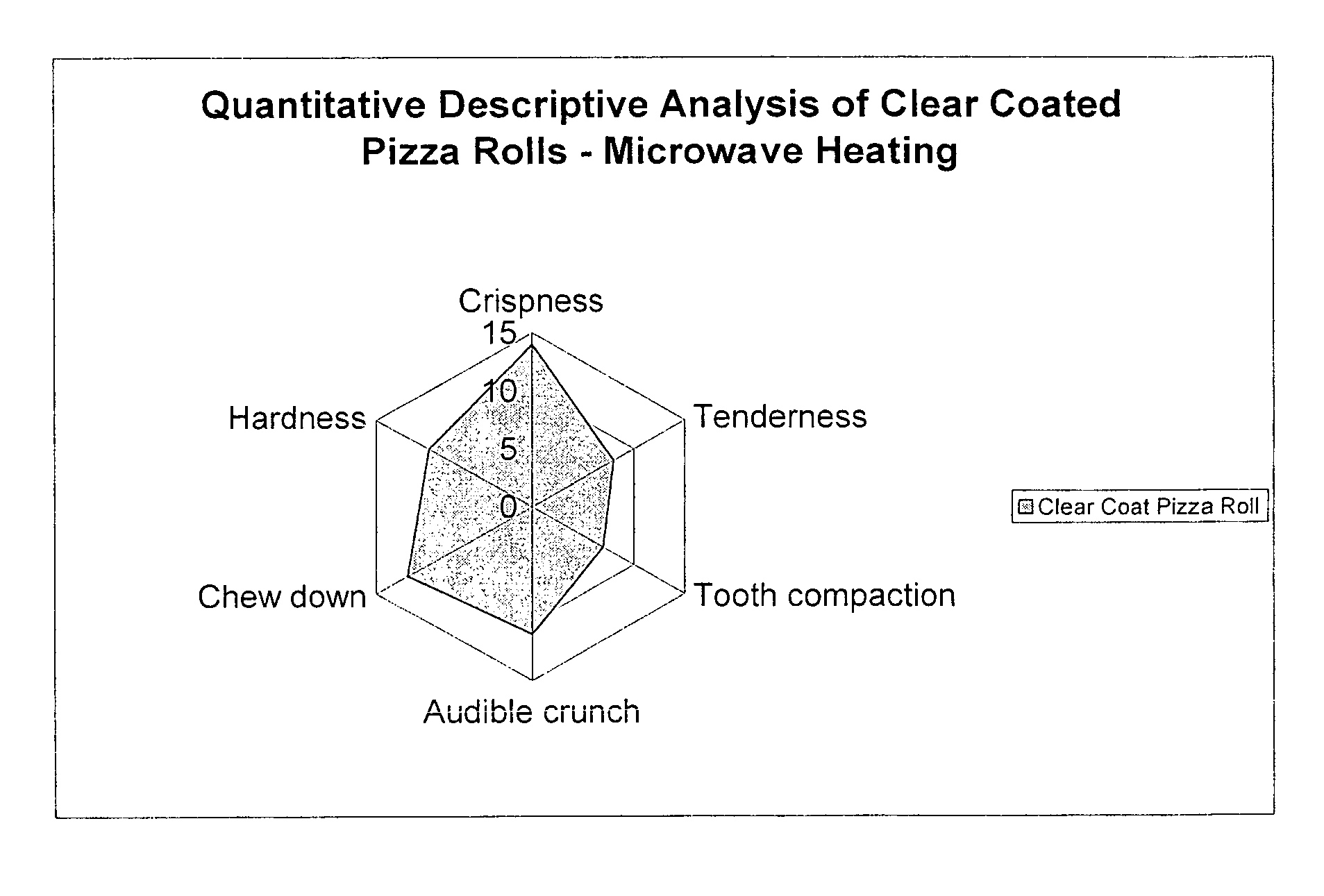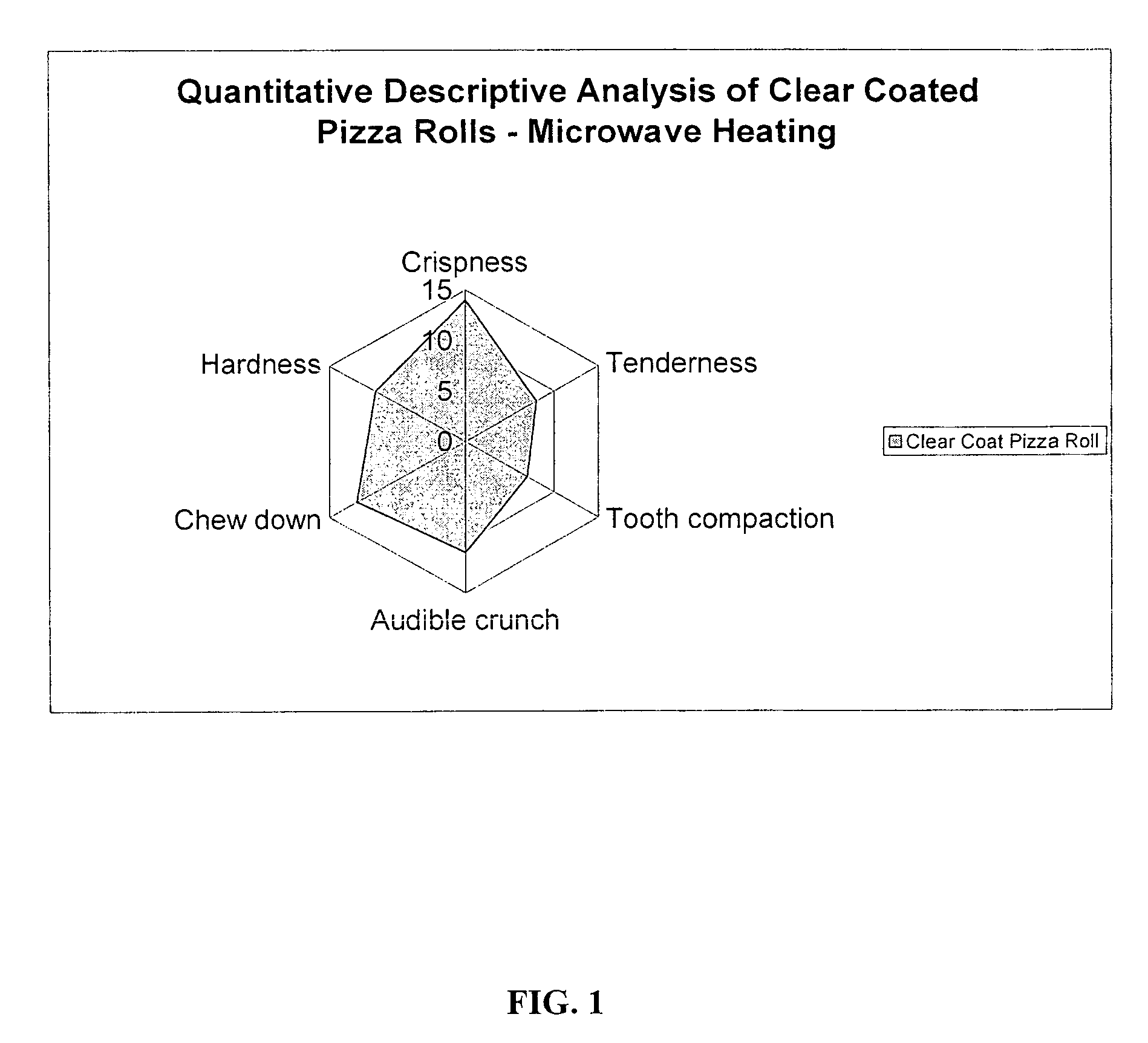Dough-enrobed foodstuff
a technology of enrobed foods and enrobed flour, which is applied in the field of enrobed foodstuffs, can solve the problems of high amylose ingredients, poor taste, and high cost of packaging components, and achieve the effects of enhancing organoleptic properties, clear appearance, and increasing crispness and tenderness
- Summary
- Abstract
- Description
- Claims
- Application Information
AI Technical Summary
Benefits of technology
Problems solved by technology
Method used
Image
Examples
example 1
[0042]A dough-enrobed foodstuff with a coating composition of the present invention applied to the external surface of the foodstuff in the form of a wet slurry was formed. The coating composition was substantially clear upon thermal processing and provided a crisp surface on the foodstuff.
[0043]First, standard frozen pizza rolls were removed from a retail package and allowed to thaw. The surface of the pizza rolls were then dried with a paper towel. A coating composition of the present invention in the form of a wet slurry was prepared with the following general formula:
[0044]
Percentage by weightIngredientof FormulaCrosslinked potato starch46.88%(about 20% or less amylose)Corn dextrin44.00%(about 25% or less amylose)120 U.S. Mesh size rice flour 6.00%(about 19% or less amylose)Salt 3.00%Xanthan gum (stabilizer) 0.12%
[0045]The solids content of the coating composition was about 46% with a viscosity of about 13.2 Stein Cup seconds. The thawed, dried pizza rolls were dipped into the c...
example 2
[0046]In this Example, a dough-enrobed foodstuff with increased crispness was prepared by adding the coating composition of Example 1 as a dry additive to the dough. First, a dough was prepared and about 15% by dry weight of the raw dough of the clear coating composition was added to the other dough ingredients. The dough was rolled out using an AL DENTE″ pasta machine manufactured by VILLA WARE® of Cleveland, Ohio, set at a thickness of 2 millimeters (size setting No. 5). The flattened dough was then cut into about 3.8 centimeters (1.5 inches) wide strips. Approximately 5 grams of tomato-based pizza flavored filling and cheese were placed on one end of the flattened dough and the flattened dough was lightly sprayed with water. The dough strips were folded over the filling and the edges pressed to seal. The edges were then trimmed so the dough-enrobed foodstuff weighed from about 10 grams to about 12 grams. The dough-enrobed foodstuff was then placed in a fryer of heated oil, heated...
example 3
[0048]A dough-enrobed foodstuff with a coating composition of the present invention applied in dry form to the external surface of a raw dough-enrobed foodstuff was formed. The coating composition was substantially clear upon thermal processing and provided increased crispness to the surface of the foodstuff.
[0049]The coating composition of Example 1 in dry form was dusted onto both sides of raw pizza rolls. As a comparison, raw pizza rolls were dusted on both sides with potato dextrin only and pregelatinized, modified tapioca starch only. Water mist was then sprayed onto the surface of both sides. The coated, raw pizza rolls were placed in a fryer of oil heated to about 185° C. (365° F.) and fried for about 120 seconds. As a control, uncoated, raw pizza rolls were thermally processed in the same manner. The fried pizza rolls were allowed to cool and then placed into a freezer until frozen. The frozen pizza rolls were packed into the original retail pack and stored in the freezer at...
PUM
 Login to View More
Login to View More Abstract
Description
Claims
Application Information
 Login to View More
Login to View More - R&D
- Intellectual Property
- Life Sciences
- Materials
- Tech Scout
- Unparalleled Data Quality
- Higher Quality Content
- 60% Fewer Hallucinations
Browse by: Latest US Patents, China's latest patents, Technical Efficacy Thesaurus, Application Domain, Technology Topic, Popular Technical Reports.
© 2025 PatSnap. All rights reserved.Legal|Privacy policy|Modern Slavery Act Transparency Statement|Sitemap|About US| Contact US: help@patsnap.com


